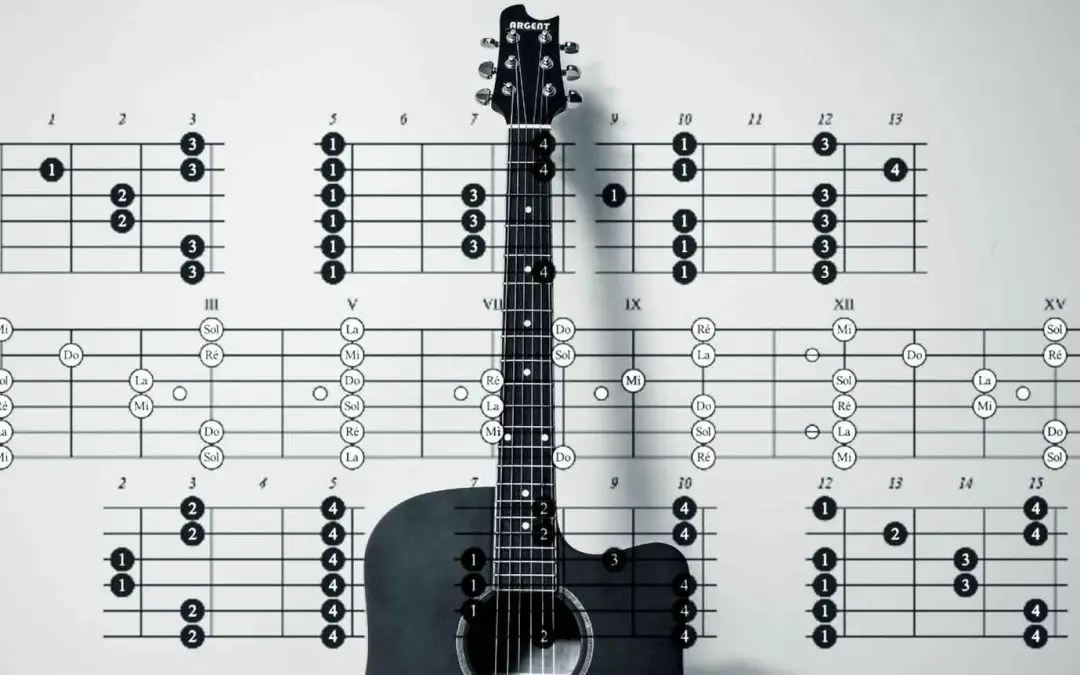Are you tired of your guitar solos sounding like a random string of notes thrown together by a tone-deaf squirrel? If so, fear not! We’re here to help you unlock the secrets to guitar soloing success by mastering scales and intervals. Get ready to rock your way to the top of the charts with killer solos that will make even the most seasoned axemen bow down in awe. So grab your guitar, buckle up, and get ready for a musical journey that will have you shredding like a pro in no time. Let’s turn those scales from fishy to phishy and those intervals from meh to amazing!
Contents
- 1 Understanding the Foundation of Scales in Guitar Soloing
- 2 Exploring the Major and Minor Scale Patterns
- 3 Diving Deep into Intervallic Relationships for Melodic Soloing
- 4 Incorporating Pentatonic Scales for Expressive Solo Work
- 5 Expanding Your Soloing Palette with Modes
- 6 Practical Application: Linking Scales and Intervals in Your Solos
- 7 Essential Practice Routines for Masterful Scales and Intervals Execution
- 8 FAQs
- 9 Rock On!
Understanding the Foundation of Scales in Guitar Soloing
Have you ever felt like you’re randomly poking at the strings on your guitar while attempting to solo? Fear not, my fellow fretboard flailer! is the key to unlocking the mysteries of shredding like a pro.
Imagine scales as the building blocks of your solos, like Legos for your fingers. Each scale is like a different flavor of ice cream – some are sweet and melodic, while others are spicy and intense. By familiarizing yourself with these scales, you can create tasty licks and riffs that will have your audience begging for more.
So, how do you go about mastering the art of scales in guitar soloing? Here are a few tips to get you started:
- Start with the basics: Begin by learning the major and minor scales. These are the bread and butter of soloing and will serve as your foundation for exploring other scales.
- Practice, practice, practice: Just like anything worth mastering, practicing your scales is key. Set aside some time each day to run through different scales and patterns on your guitar.
- Experiment and explore: Don’t be afraid to step outside your comfort zone and try new scales. Mix and match different scales to create unique combinations that will set your solos on fire.
Remember, the key to becoming a guitar soloing superstar lies in understanding and mastering the foundation of scales. So grab your guitar, buckle up, and get ready to rock your way to soloing stardom!

Exploring the Major and Minor Scale Patterns
When it comes to major and minor scales, it’s all about patterns! Understanding these patterns is like cracking the code to unlock the secrets of music. So, grab your imaginary detective hat and let’s go on a musical mystery adventure!
First up, let’s talk major scales. These happy-go-lucky scales are like the life of the party in the world of music. The pattern for a major scale is like a recipe for the perfect cupcake – you need just the right ingredients in just the right order. It’s all about those whole steps and half steps, baby! And once you’ve got that pattern down, you’ll be soloing like a rockstar in no time.
Now, onto the dark and mysterious minor scales. These scales are like the brooding antiheroes of the music world – they may be a little moody, but they sure do pack a punch. The pattern for a minor scale is like a cryptic puzzle that you have to solve with your ears. Those pesky accidentals and raised 7th degrees can throw you for a loop, but once you crack the code, you’ll be weaving musical magic!
So, whether you’re grooving to a major scale or getting lost in the depths of a minor scale, remember that it’s all about those patterns, baby! Embrace the quirks and idiosyncrasies of each scale, and let your musical imagination run wild. Who knows, you might just stumble upon the next big hit! Happy exploring!

Diving Deep into Intervallic Relationships for Melodic Soloing
Ever feel like your solos are just missing that special something? Well, it might be time to start diving deep into intervallic relationships to elevate your melodic soloing game!
Understanding how different intervals interact with each other can add a whole new dimension to your solos. By incorporating intervals like the minor 3rd or perfect 5th, you can create tension and release that will keep your listeners on the edge of their seats.
Don’t be afraid to experiment with unconventional intervallic relationships – you never know what magic you might discover. Try incorporating the tritone or diminished 7th for a touch of dissonance that will make your solos really stand out.
Ultimately, mastering intervallic relationships is all about finding the right balance between consonance and dissonance. So go ahead, dive deep into the world of intervals and watch your melodic soloing skills soar to new heights!

Incorporating Pentatonic Scales for Expressive Solo Work
Have you ever hit a wall in your solo work and thought, “Man, I just can’t seem to break through”? Well, fear not my fellow musicians, because incorporating pentatonic scales into your solos is here to save the day!
Picture this: you’re on stage, shredding away on your guitar like a rock god, when suddenly you whip out a pentatonic scale that sends chills down the audience’s spines. The beauty of pentatonic scales is that they are simple yet oh so effective in creating emotion and intensity in your solos. Plus, they’re like the Swiss Army knife of scales - versatile, reliable, and always ready to impress.
With pentatonic scales, you can effortlessly transition between different keys and modes, all while adding a touch of flair to your solos. And the best part? You don’t need to be a music theory genius to master them. Just pick a key, learn the patterns, and watch as your solos take on a whole new dimension of expression and creativity.
So, next time you feel stuck in a musical rut, remember the power of pentatonic scales. Trust me, your solos will thank you. Rock on, fellow shredders!

Expanding Your Soloing Palette with Modes
If you’re tired of playing the same old guitar solos and feeling stuck in a musical rut, it’s time to think outside the box. By exploring different modes, you can expand your soloing palette and add a unique flavor to your playing.
Each mode has its own distinct sound and characteristics that can bring a fresh perspective to your solos. From the mystical sound of Phrygian mode to the exotic vibes of Dorian mode, there’s a world of possibilities waiting to be explored.
So, grab your guitar, dust off those scales, and get ready to embark on a musical journey like no other. Step out of your comfort zone and venture into the world of modes – you’ll be amazed at the creative possibilities that await you!
With time and practice, you’ll be able to seamlessly weave these modes into your solos, creating dynamic and captivating performances that will leave your audience in awe. So, don’t be afraid to experiment and push the boundaries of your musical creativity – the world of modes is yours to conquer!
Practical Application: Linking Scales and Intervals in Your Solos
So you’ve learned about scales and intervals, but how do you actually apply them in your solos? Fear not, young grasshopper, for I shall guide you on this magical journey of musical exploration.
First and foremost, you must understand that scales and intervals are like peanut butter and jelly – they complement each other perfectly. When you’re soloing, think of scales as the canvas and intervals as the paint. Experiment with different combinations to create a masterpiece of sound.
Now, let’s talk about linking scales and intervals in your solos. Here are some practical tips to get you started:
- Mix it up: Don’t stick to one scale or interval pattern throughout your solo. Mix and match to keep things interesting.
- Focus on transitions: Pay attention to how you move from one scale to another using intervals. Aim for smooth and seamless transitions.
- Use repetition: Repeat certain intervals or scale patterns to create a catchy hook in your solo.
Essential Practice Routines for Masterful Scales and Intervals Execution
When it comes to mastering scales and intervals, practice truly does make perfect. Here are some essential routines to help you become a virtuoso in no time:
Scale Variations: Make sure to practice your scales in every possible variation - ascending, descending, in thirds, fourths, fifths, and even in harmonics for an added challenge.
Interval Jumps: Jumping intervals can be tricky, so spend time practicing jumping from different intervals smoothly and accurately. Start with small intervals and work your way up to larger leaps. It’s all about precision and control!
Finger Flexibility: To execute scales and intervals flawlessly, finger flexibility is key. Incorporate exercises that focus on finger independence and dexterity to ensure that each note is played with precision.
FAQs
How can mastering scales and intervals improve my guitar soloing skills?
Ah, my fellow guitar enthusiast, mastering scales and intervals is like unlocking a secret code to mesmerizing soloing. It gives you the tools to navigate the fretboard with ease, add flavor to your solos, and unleash your creativity to new heights.
What are some essential scales every guitarist should know?
Oh, darling guitarist, the possibilities are endless! But some essential scales to start with are the pentatonic scale, the major scale, and the natural minor scale. These bad boys will set the foundation for your soloing adventures.
How can intervals spice up my guitar solos?
Ah, intervals, the spice of life for any guitarist! By incorporating intervals into your solos, you can create tension, add emotion, and surprise your audience with unexpected twists and turns. Get ready to take your solos from bland to grand!
Any tips for memorizing scales and intervals?
Fear not, my fretboard friend, memorizing scales and intervals doesn’t have to be a daunting task! Break them down into smaller chunks, practice with a metronome, and most importantly, have fun with it. Before you know it, you’ll be shredding like a pro!
How can I apply scales and intervals to my own guitar solos?
Oh, eager guitarist, the world is your oyster! Experiment with different scales and intervals over backing tracks, analyze solos from your favorite guitar gods, and most importantly, trust your ears and let your creativity run wild. Before long, you’ll be crafting solos that will leave jaws dropped and ears ringing!
Rock On!
Congratulations, you’ve taken your first step towards becoming a guitar soloing master! Embrace the scales and intervals, practice until your fingers bleed (figuratively, of course), and soon you’ll be rocking out like a legend. Keep shredding, keep learning, and most importantly, keep having fun! So go ahead, grab your guitar, and let the music take you to new heights. Rock on!



